
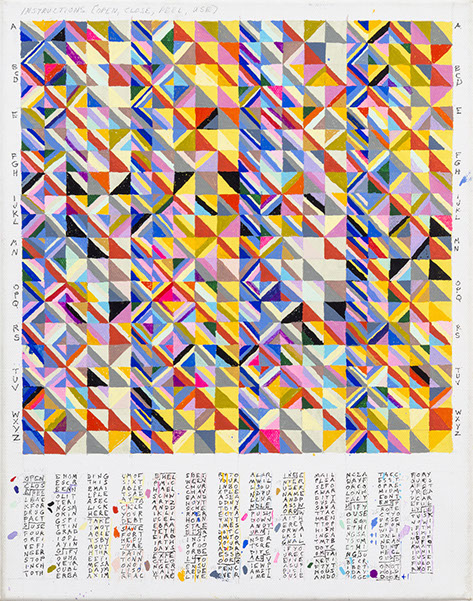
INSTRUCTIONS: OPEN, CLOSE, PEEL, USE, 2014
Acrylic gouache, graphite, colored pencil on canvas, 12" x 16"
Photograph courtesy of Leslie Roberts
Scott Robinson with Leslie Roberts
SR: Let’s start with this piece that seems pretty important, a bit of a breakthrough.
What’s it called?
LR: That one’s called INSTRUCTIONS. I have several paintings called INSTRUCTIONS; this one is subtitled OPEN, CLOSE, PEEL, USE. This other painting from around that same time is about a subway ride; L TO 6 TO 77TH AND BACK. Their texts are collections of found language. They’re on canvas, but led to the paintings I’m now making on panel. One of the things I’ve been trying to do, for two and a half years, maybe, is to make paintings that have the qualities of my drawings, and still are paintings, and still have the impact of painting.
I had made years of drawings on graph paper. I was messing with colored pencils and thinking, man, how can I make a composition I haven’t seen, that goes beyond formal decisions? So I started trying systems. I would do things like superimpose one pattern over another. I used phone numbers to create a randomness of sorts.
Pretty soon I found text was more fun than phone numbers. Those early texts are quite personal but also very ordinary, stuff from everyday life. Based on, for instance, my to-do lists. Part of one drawing reads: “Fax new thing to accountant.” And “Repair side of house” and “Hide birthday surprises.” And also “Avoid wasting time on grids like this.” I have lots of drawings. I have boxes full. Now when I look back and I see all those to-do lists, I see sort of a picture of my life.
For a long time the drawings were, to my mind, just playing, while I was making other work. But I started getting more interested in them. I was probably able to find something important in these drawings because, when you don’t think you’re making your work, then you get ideas! And at first you doubt them, you think, “I don’t know.” It takes a while. You have to recognize when you’re letting go and making the nothing that’s going to become important.
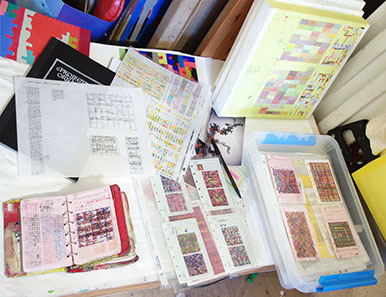
Studio of Leslie Roberts
Photography: Scott Robinson
Then during the change in the work a couple of years ago –in part, moving from mainly drawing to mainly painting– I felt more interested in the found language aspect than in writing about my private life. I had started to make paintings based on collections of language: collecting instructions from all different sources, for example, everything from how to save someone’s life to product manuals. Or lists of ways to say “no” –nope, no way, forget it– things like that. Or lists of guarantees, warnings, questions…
Studio of Leslie Roberts
Photography: Scott Robinson
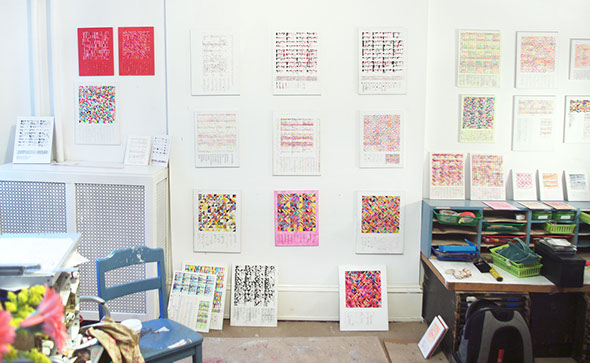
SR: Before we set up this interview, I sent you a quote from Gerhard Richter’s notes in 1986 that I love and I thought it paralleled your approach to appropriating text. Then I found out that you were already very familiar with it. He says “I see countless landscapes, photograph barely 1 in 100,000, and paint barely 1 in 100 of those that I photograph. I am therefore seeking something quite specific; from this I conclude that I know what I want.”
LR: Reading that statement made a major impact on me. Randomness interests me intensely, in part because you almost never attain it, although you think you do. I’ll give my students an assignment to make a grid randomly filled with color, and then I’ll ask “did you feel like you should put a red over here because you put one over there?” Which, of course, they did. In other words, unless you throw dice or find some other system, it isn’t going to be random.
But that quote struck me for another reason. In part, Richter was acknowledging that some of the claims he had made as a young artist, he had to realize later, were not quite what was happening. He had presented that early work as a system for making paintings where in some ways he wasn’t in control. But inevitably he was. His choices weren’t random. But that took him years to realize. It has been crucial to me to understand how long it can take to recognize what you’re actually doing as an artist.
Richter said something similar, in that same collection of writings and letters, about his so-called abstract paintings, the squeegeed ones. When he first made them, he presented them as simulacra of paintings, not “genuine” abstract paintings. Then later on in that book someone asks him about those and he gets quite offended, and he’s like, “how are mine any less beautiful than De Kooning?!”
I’d thought about that first quote in relation to the visual aspect of my work. It’s interesting to consider it in relation to the appropriated text. I do think the content of my text matters, even when I’m not overtly constructing meaning. There are all those to-do lists, but now also these collections of found language. Honestly, I think those too are all about me. I think you’re right, that’s exactly Richter’s point.
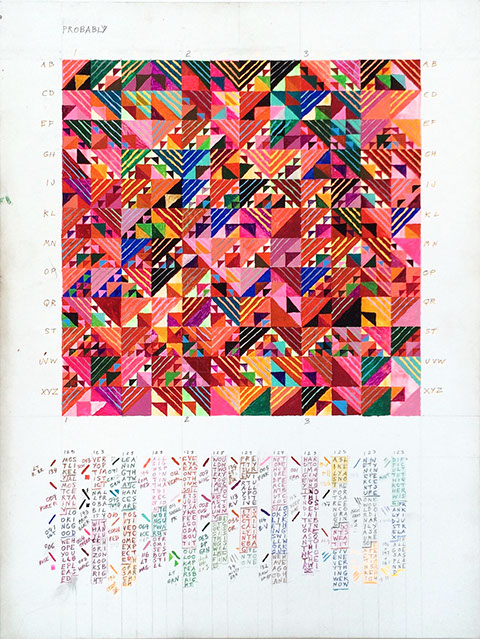
PROBABLY, 2016
Acrylic gouache, ink, graphite, colored pencil on gessoed panel, 11" x 14"
Photograph courtesy of Leslie Roberts
SR: Can you talk more about how you went about finding your way to something more random?
LR: Before I was making those graph-paper studies or taking them seriously, I was using jigsaw puzzles in my studio work. So I would put the puzzle together. I’d turn it over so I could number all the pieces and then take them apart so I could paint them “randomly." And then I’d put them back together and if it didn’t work, I would take it apart again and repaint. I would spend a long time looking at those puzzles –which I only have a very few images of online. Picture puzzles with comic book imagery –like Spiderman and Minnie Mouse– I’d paint the edges of pieces so you just see little bits of the imagery. The process created weird relationships I might appreciate in a big painting, but I wouldn’t have painted as an intentional composition. I really had to take it apart, do stuff, and put it back together.
With both the puzzles and the grids, I was playing games to find different ways of doing it –in the first small date-book drawings, for example. These two squares both started out red with yellow centers. How different could I make them? Little games, little challenges.
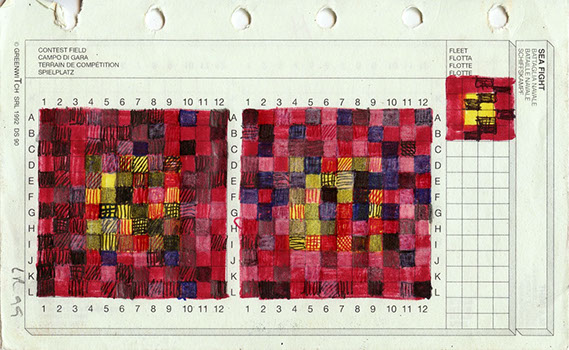
Yellow Centers, 1999
Mixed media, 5" x 3"
Photograph courtesy of Leslie Roberts
Finally, one way to have a system was words. At first I wrote just anything –poems I could remember, like “Full fathom five thy father lies.” Or I would write my son’s name, his birthday, all about him. Or sometimes I’d write things I could remember from the past. All the clothes I can remember owning, I made a drawing about that. Or free thoughts… I just needed some words, so I would free-associate. I would write about doubts and fears. In one earlier drawing, MY NEW LIFE, a phrase jumps out: “stop this right now” –I know when I wrote that I worried, “why am I making these drawings so full of negative content?” Partly, at that point, the content probably filled a need to just write it out. It was a transitional period in my life. I had just gotten divorced. I had a little kid. I was having relationships, and breaking up... it wasn’t meant for anyone else to see. I only needed the text to have a system to NOT make formal compositions. The process wasn’t really meant to be cryptic.
But eventually I got more interested in documentation –cataloging things around me. For instance, making sort of a word picture of a trip, or of a place, wherever I happened to be. So I was starting to record signs, ads, book titles –found language.
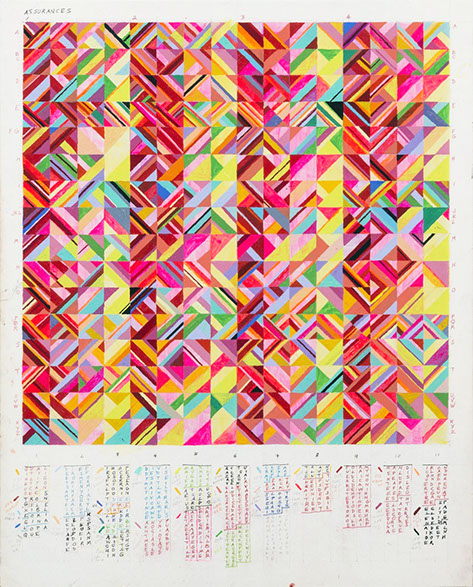
ASSURANCES, 2014
Acrylic gouache, graphite, colored pencil on panel, 16" x 20"
Photograph courtesy of Leslie Roberts
So looking at this painting, ASSURANCES, it’s found language, a list of guarantees. I’ll read some of the examples I wrote down, thinking about Richter’s point about unconscious choices:
“Strong, flexible, original, opaque... deep, fresh... the purest and finest ingredients... differs from others in many important particulars... data presented in a clear readily intelligible manner, specially designed; made like no other...”
Or text from the painting WARNING: “May lose value; Do not eat; Past performance is no guarantee of future results...”
Some of these words could be about me, or about my work, or my hopes, or comments about life, or about art generally.
SR: It sounds like a broad residue of everything that you experience.
LR: Right. Sometimes I feel my process is a little bit like still-life painters’. You know, they use whatever objects are around: but of course they are not just any objects.
SR: Are there any other experiences that you think predispose you to working with text?
LR: For ten years I made my living as a copy editor and writer of textbooks. I am officially supposedly a good writer. I help write documents in my department. I help friends with writing sometimes. Yet in a way, my process undercuts some of my writing agency. Collecting words that aren’t mine and stringing them together, as opposed to writing and revising and re-revising. I will occasionally type these excerpts of found language –especially now that I have an iPad– and arrange them, to some extent, ahead of time. But mostly the writing accumulates as I work, until I see how many words I need.
I am not formally composing. But I am kind of enjoying the rhythm as I write these lists down. I think they’re a little poetic, though they’re not poetry. They’re also funny, and sometimes a little sinister, especially when I start collecting sentences from end-user agreements and contractual language.
SR: Do you think humor is important? I’m no expert, but I know that not many philosophers have written about it. I’m a little familiar with the concept of incongruity in humor that suggests something is funny because it violates our expectations.
LR: I do. Humor is kind of mysterious, right? To define why anything is a joke… Some of those early drawings were really quite morose, but still kind of funny. There is also such a pleasure in non sequiturs. As in that painting ASSURANCES, again:
“Helps keep you safe and informed... kiln dried, beveled, erases without ghosting... divided systematically into various narrow fields, actual sizes are given, extra creamy, slots for easy hanging, the risk of material loss is considered remote, translucent, formulated with the findings of modern scholarship... iron-clad 100% guarantee...”
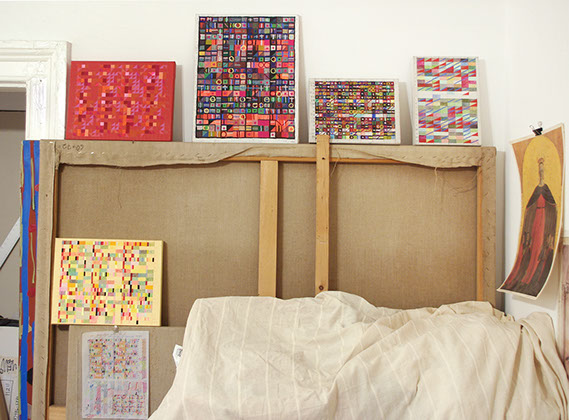
Studio of Leslie Roberts
Photography: Scott Robinson
SR: Some of the earlier paintings lack text –why is that?
LR: It felt natural to put words on paper. But when I started occasionally trying to make this work as painting, I went back and forth about including text, and how to do that. Then two or three years ago I just thought: I want to make paintings. I felt like I had so many drawings. I wanted to use color differently. And my son was in college. My life cleared out a little bit. I realized my job was eating me up and I needed to re-find myself. I also started applying to residencies for the first time in over 20 years. A residency at the Viriginia Center for the Creative Arts (VCCA), in 2014, was incredibly important.
And I just really wanted to figure out how to make in painting something close to the drawings.
So I stopped the back-and-forth and decided there was going to be text in the paintings. I decided the text makes a real difference in the drawings visually and conceptually, so the paintings need it too.
I also started to realize I didn’t want the work to be confessional. Some of my drawings, if actually deciphered, would be too personal: either too depressing or too intimate. In some of the drawings it’s fine. It’s very direct. I’m just writing things. But that tone is not what I would like my paintings to be about or what I think their spirit is.
SR: Could someone decipher these if they really wanted to?
LR: Possibly a really determined and good CIA agent! But I don’t think so. Maybe with a computer to analyze probability...
SR: They tend to look very digital, but it sounds like that’s a coincidence.
LR: It’s not a coincidence although it’s not planned. Again, an example of not being aware of how you’re taking control.
Or the format I’m using now, flat 3/8 inch-thick gessoed panels, rather than canvases: the flat panel felt right but it took a while for me to think through why. It’s because they are more like pages, in size and also in their thinness. They’re paintings that are leaning in the page direction. A friend here recently said these are like pages that got really thick. I loved that. Another friend said they’re like little kids’ chalkboards. They’re also like the iPads and tablets we all have now.
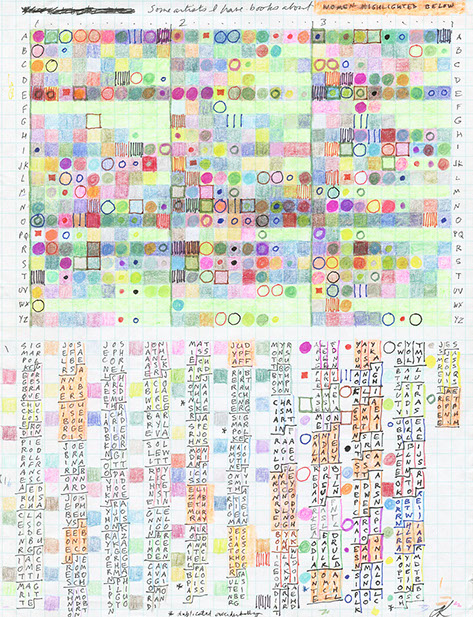
Some artists I have books about, 2014
Colored pencil on graph paper, 8.5" x 11"
Photograph courtesy of Leslie Roberts
SR: How do you choose colors?
LR: I worry I only have two palettes: either black, white and red, or else it’s everything. But I don’t want them to be rainbow.
Whatever color I choose, I’m placing it according to a system, and there’s some gritting my teeth: “I AM JUST GOING TO KEEP GOING WITH THIS!” But then also questioning: “Wouldn’t it look nice to stop?”
However, at the same time, I’ve never made a painting where I just randomly grab color. I could just pull tubes of paint out of a bag, but I haven’t. There’s a lot of intuition involved.
I teach color mixing and I rarely mix color any more. It mixes optically. I use it pure because the pigment is more intense. Actually, Albers did the same thing. All of those Albers squares within squares: none were mixed, they are all out-of-the-tube pure pigments. I didn’t start out with that idea, but you do what makes sense and later you might realize why.
SR: Do you alter your system to achieve a certain look, or are you working against that?
LR: I would say both. I feel like it is in part related to what Richter said, in that I rarely approach these paintings with some predetermined palette, but I keep going with them until visually, they are compelling to me –and hopefully, kind of weird, something that is mine but that I couldn’t have imagined. It would be false to say that I’m not in control, that these are algorithms where I just plug things in. No. There’s a balance there.
Sometimes when I get to the end of my text, or as much as I was able or willing to use, I just leave it and decide that it’s fine: it is enough. Or sometimes when a lot of squares are left empty, I will find a way to deal with them. As in this drawing, SOME ARTISTS I HAVE BOOKS ABOUT, at the end I filled all the empty squares with green. So that is also a way that I control it. Or if it needs more, occasionally I’ve gone back over the whole thing again.
SR: What’s one where you can walk me through the mark-making process, the decisions on how the colors and the lines are made.
LR: CAPITALIZATION. The text here I took from an old dictionary that was in my studio at VCCA –just rules for capitalizing sentences, but they were poignant to me. “The beginning of a word or phrase, standing independently like a sentence.” I thought, “independently like a sentence” –what a beautiful line.
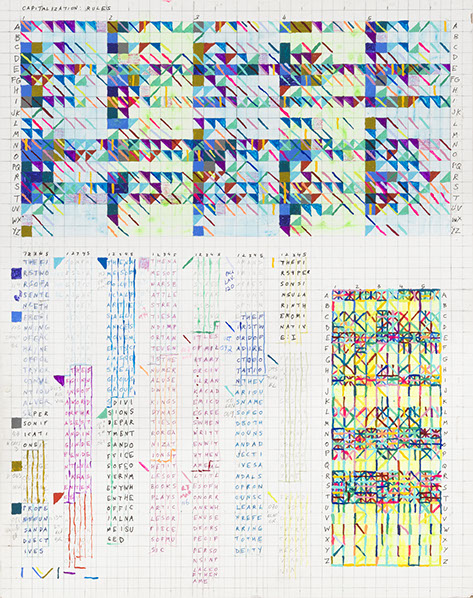
CAPITALIZATION, 2015
Acrylic gouache, graphite, colored pencil on panel, 11" x 14"
Photograph courtesy of Leslie Roberts
Here, the text is coded in two grids, a larger and a smaller. So I decide I’ll try to make something blue and green, since I never do, and I put down a blue and green ground in the larger grid. Then I decide, okay, five columns. I am always counting and figuring out if I have to use centimeters or inches, how many columns do I want, a few squares, a whole lot of units... sometimes they aren’t square.
It’s numbered columns and alphabetized rows. The number of columns in the grid is the same as the number of columns of letters. The alphabet is usually handicapped, meaning some rows include more than one letter. So the larger grid has 20 rows. If I always let it be 26 rows (an interesting prime number, by the way), a square grid doesn’t divide up nicely into columns.
And with one row per letter, the E row would always be the densest, unless I made an effort to do something crazy to avoid that in the text, like in novels written without the letter E.
J’s and K’s, even when you group them together, are few. Every now and then I will be working on something and I think, I better find a phrase that has a J in it or a Z in it. That will play into the language choice sometimes.
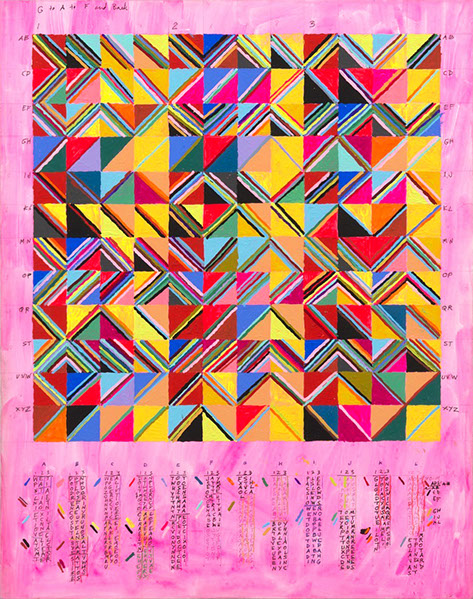
G to A to F and back, 2015
Acrylic gouache, graphite, colored pencil on panel 11" x 14”
Photograph courtesy of Leslie Roberts
SR: And there are some squares that don’t get filled. The B’s are strangely lacking.
LR: It’s amazing how few B’s there are in English. I have a beautiful diagram of letter incidence that someone made years ago, so no need to make it myself. But yes, I am always handicapping against letter frequency.
So the initial phrase: “The first word of a sentence.” I use one color for that whole phrase, and mark that –see the blue square beside it –and also usually write down the number of that acrylic gouache color. So column one: TRRSN, column two: HSDCC, and so on, all filled with that particular blue.
(I looked at this painting recently with someone else, and saw I left out a square very early on. They all have mistakes. I will freak out, and then I realize “no one will ever know.”)
When I make paintings that have two grids, like this one, it’s going back to what I was doing with the drawings –just playing. Using the same colors but a different system, or even just in a differently proportioned grid. Here the small grid has 26 rows and is based on a series of lines. First verticals, then diagonals, then horizontals. So the same colors and same text produce two different structures.
Sometimes I try not to care if I cover up the original colors. Other times I am trying to figure out a way to make each added element visible, as in those two up there: HIGHLY RECOMMENDED and FYEO.
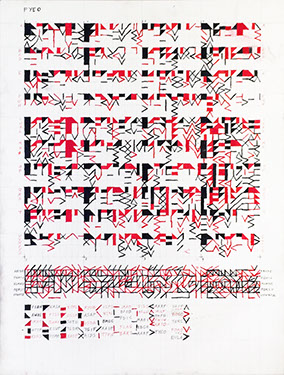
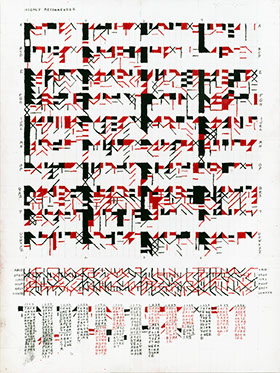
FYEO, 2016
Acrylic gouache, ink, graphite, colored pencil on gessoed panel, 12" x 16”
Photograph courtesy of Leslie Roberts
HIGHLY RECOMMENDED, 2016
Acrylic gouache, ink, graphite, colored pencil on gessoed panel, 12" x 16”
Photograph courtesy of Leslie Roberts
The text of FYEO and of some others are acronyms, which by their nature are double coded, meaning I don’t have to include the abbreviated words themselves in the texts, but I put the words in the paintings.
It’s very methodical, how they’re constructed, even though they look complicated. The way I’m using these systems, I think about musical notation.
I used to think a lot about gamelan music from Bali, which I don’t know a whole lot about, but I love it. A gamelan is a large group of players; what each person is playing is fairly repetitive and simple but gradually, as it all adds up, it becomes so complex.
I feel like my paintings are made so simply. I have an A here, therefore I have to put a red square there. It’s just a very systematic addition of layers or divisions, going over and over each row as necessary, but eventually it becomes intricate.
SR: Are these all acrylic gouache?
LR: Yes, almost all of them, with ink, colored pencil, graphite. There are a few on paper mounted on panel, made with drawing media. This one, ARTISTS, is largely colored pencil and marker.
This is a list of artists’ names, all women. To talk about another work’s process: I went through this whole list of names, one color for each name. Then felt it needed more. So I went back and added fluorescent pink hatching for anyone I’ve met. And if an artist’s work was arguably geometric, I added black diagonal lines to create parallelograms.
Sometimes before applying another rule, I have to ask, “If I were to make this move, will I even have room for it?”
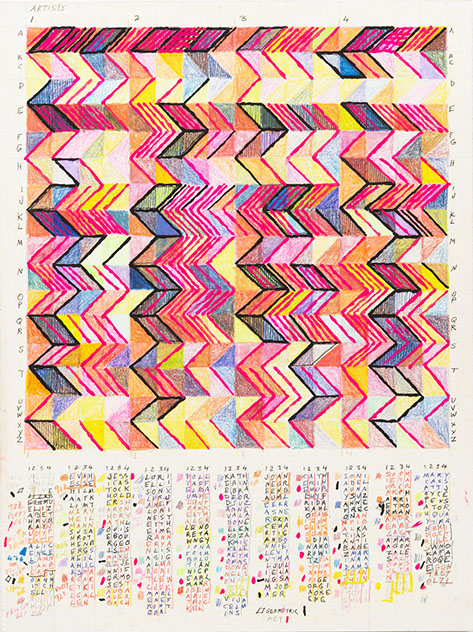
ARTISTS, 2015
Acrylic gouache, graphite, colored pencil on paper mounted on panel, 9" x 12"
Photograph courtesy of Leslie Roberts
SR: Do these rules work to give you a sense of freedom within limitations?
LR: So there’s an Eva Hesse quote –another one of my favorites. "Vision or concept will come through total risk, freedom, discipline." You can’t have risk unless you have some limitation. If you have rules, then you have something to break. If you don’t, it’s overwhelming: you feel you can do anything.
I think in part, I need rules and systems to make something other than a formally or expressively beautiful composition –whether it’s because I teach formal composition and design, whether it’s because that’s my nature, or whether it’s because I went to grad school in the 80’s –where formal beauty was dismissed as the dumbest thing ever (which I no longer believe).
So with earlier works using puzzles, and with these, I’ve found systems and games and challenges and ways to have some control. Tons of control.
SR: It’s interesting to me that a paradoxical part of your control is that you intentionally abandon intentional composition.
LR: Flannery O’Connor was asked about the meaning of her stories. Have you read her letters? I cannot lend them out, you have to get them because I cannot risk losing them! But about the meaning in her stories –I might be paraphrasing– she says, “I am like the little old lady who says ‘I never know what I think until I see what I say.’ ”
SR: Wow, that’s well said.
LR: O’Connor is amazing. In something of the same spirit: I want to get away from what I think is going to be the right thing, whatever that is. I don’t want to do the right thing. I want to do the wrong thing that turns out to be right.

Wanted, NYC, 2016
Acrylic gouache, ink, graphite on panel 9" x 12"
Photograph courtesy of Leslie Roberts
Scott Robinson is an artist in Brooklyn, NY and the founder of Painting Is Dead
Leslie Roberts has had solo exhibitions at New York’s PPOW, Eyewash, and Holiday Galleries, and has been included in numerous group exhibitions in the US and abroad. She has had residencies at Ragdale, the Virginia Center for the Creative Arts, and Yaddo, as well as a scholarship to Skowhegan. Upon receiving a BA from Yale, she was awarded Yale’s John Courtney Murray Fellowship for independent work abroad, in Paris. She also studied at the New York Studio School and received an MFA from Queens College, CUNY. A professor at Pratt Institute, she teaches Foundation Light, Color, and Design. She was born in North Carolina and lives and works in Brooklyn. She has been featured in publications such as Artforum, The Brooklyn Rail, and NY Arts, among others.
Disclaimer: All views and opinions expressed are those of the authors and do not necessarily reflect the views of the editors, owner, advertisers, other writers or anyone else associated with PAINTING IS DEAD.
